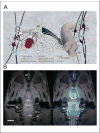The Glymphatic Pathway: Waste Removal from the CNS via Cerebrospinal Fluid Transport
- PMID: 28466758
- PMCID: PMC5547012
- DOI: 10.1177/1073858417691030
The Glymphatic Pathway: Waste Removal from the CNS via Cerebrospinal Fluid Transport
Abstract
The overall premise of this review is that cerebrospinal fluid (CSF) is transported within a dedicated peri-vascular network facilitating metabolic waste clearance from the central nervous system while we sleep. The anatomical profile of the network is complex and has been defined as a peri-arterial CSF influx pathway and peri-venous clearance routes, which are functionally coupled by interstitial bulk flow supported by astrocytic aquaporin 4 water channels. The role of the newly discovered system in the brain is equivalent to the lymphatic system present in other body organs and has been termed the "glymphatic pathway" or "(g)lymphatics" because of its dependence on glial cells. We will discuss and review the general anatomy and physiology of CSF from the perspective of the glymphatic pathway, a discovery which has greatly improved our understanding of key factors that control removal of metabolic waste products from the central nervous system in health and disease and identifies an additional purpose for sleep. A brief historical and factual description of CSF production and transport will precede the ensuing discussion of the glymphatic system along with a discussion of its clinical implications.
Keywords: brain; cerebrospinal fluid; glymphatic pathway; microcirculation; transport.
Conflict of interest statement
The author(s) declared no potential conflicts of interest with respect to the research, authorship, and/or publication of this article.
Figures







References
Publication types
MeSH terms
Grants and funding
LinkOut - more resources
Full Text Sources
Other Literature Sources

